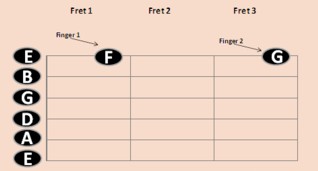Beginner Classical Guitar - Lesson 1: Notes on the E string
All these free beginner classical guitar lessons have the same format. Have a look at how this page is layed out and become familiar with where things are.
The lesson starts with a breakdown of the lesson aims. This is followed by tips and guidelines - these are really essential so don't skip past these.
Then you'll get your guitar pieces that support the aim of the lesson and supporting resources which include accompaniment in video format and the sheet music.
These lessons are designed for the beginner classical guitar player or as assistance to the classical guitar teacher.
I’m getting a lot of messages from people coming here because they want to learn to play guitar as part of worship. If this is you, you might want to join Aaron Anastasi’s programme. Aaron is a musician and a worship leader. He put together a step by step programme for aspiring Christian musicians. If you're interested, you can use the exercises and advice in learn-classical-guitar-today to develop your finger strength and dexterity and Aaron's lessons to work on strumming and worship music.
CLICK HERE TO LEARN WORSHIP GUITAR !!
The lessons builds step by step with each lesson building on the previous lesson in three important ways:
- Knowledge of guitar technique builds steadily lesson by lesson
- Familiarity with music reading goes from a knowledge of single melodies, to question and answer melodies, to working with music in two voices.
- Each lesson works to strength and stretch the fingers just a bit more more - and in a safe way!
- This lesson series emphasises i-m-i-m movement in the right hand.
Try and play through all the exercises that I provide links for before you move onto the next lesson.
Remember, that the house with the solid foundation is stronger in the long run!
Beginner Classical Guitar - Lesson 1: Aims
- Become familiar with and practice using the notes located on the E string.
- Learn the whole note and get comfortable counting and using the whole note in music.
- Begin working with half notes and quarter notes.
- Become comfortable with placing the left hand in the correct fret and practice the correct fret placement of the fingers to avoid buzzing.
- Start using alternating i-m-i-m-i-m fingers on the right hand.
Tips and Guidelines
- Place your left hand fingers right behind the frets to get a good, clean sound. If you are hearing a buzz then your finger is probably not correctly placed.
- Use the correct fingers in the correct fret (see the diagram).
- Alternate between the i-m-i-m-i-m fingers of the right hand when plucking the strings.
See the diagram below for notes on the E string and check which fingers to use in each fret. Alternately, review the notes on the guitar fretboard.

Notice the note values. If you need to revise this aspect go to music theory. In Exercise 1 you will be playing Whole Notes; in Exercise 2 & 3 half notes and in Exercise 4 quarter notes.

You'll need to go a little deeper into music theory as you proceed. The best online resource for this is Guitar Theory Revolution. It recognises that music theory is very hard for guitarists because music theory has till now been located in the piano paradigm. The Guitar Theory Revolution overthrows the piano paradigm that is holding you back and embraces the attributes of the guitar to unpack music theory. In fact, it goes further and allows you to see that the guitar is one of the best instruments for learning theory.
Okay, let's get into playing
There are FOUR exercises that you have to move through.
Well done!
- You've finished your first lesson in this beginner classical guitar series.
- You are now familiar with and practiced in using the notes of the 1st string.
- You've practiced alternating between i-m-i-m-i-m with the right hand.
- Also, you've become familiar with and used the whole note, half note and the quarter note.
That's great progress!!!
If your hand is feeling tired, try going through these left hand exercises guaranteed to strengthen and increase the suppleness of your fingers.

You'll need to go a little deeper into music theory as you proceed. The best online resource for this is Guitar Theory Revolution. It recognises that music theory is very hard for guitarists because music theory has till now been located in the piano paradigm. The Guitar Theory Revolution overthrows the piano paradigm that is holding you back and embraces the attributes of the guitar to unpack music theory. In fact, it goes further and allows you to see that the guitar is one of the best instruments for learning theory.





